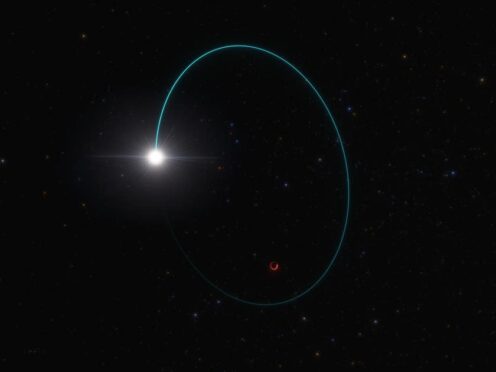Astronomers have identified the most massive black hole that formed from an exploding star to be discovered in the Milky Way galaxy.
The European Space Agency’s Gaia mission, involving UCL researchers, found the black hole, known as Gaia-BH3, which is 33 times the mass of our Sun and located relatively close to Earth at 2,000 light years away.
Gaia-BH3 was not seen directly but inferred from the movements of what appeared to be a lone star now understood to be its companion.
The discovery of the bright star nearby suggests many more black holes could be found in the next set of data to be released from the Milky Way-mapping Gaia space telescope.
The next set is not scheduled to be released before the end of 2025, researchers said.
Pasquale Panuzzo of CNRS, Observatoire de Paris, in France, who is the lead author of this finding, said: “It’s a real unicorn.
“This is the kind of discovery you make once in your research life.
“So far, black holes this big have only ever been detected in distant galaxies, by the LIGO–Virgo–KAGRA collaboration thanks to observations of gravitational waves.”
The average mass of known black holes of stellar origin in our galaxy is around 10 times the mass of our Sun.
Until now, the weight record was held by a black hole in an X-ray binary in the Cygnus constellation, which has a mass estimated to be about 20 times that of the Sun.
Dr George Seabroke, Mullard Space Science Laboratory at UCL, a member of Gaia’s black hole task force, the team that made the discovery, said: “Finding Gaia BH3 is like the moment in the film The Matrix where Neo starts to see the matrix.
“In our case, the matrix is our galaxy’s population of dormant, stellar, black holes, which were hidden from us before Gaia detected them.
“Gaia BH3 is an important clue to this population because it is the most massive, stellar, black hole found in our galaxy.
“Gaia’s next data release is expected to contain many more, which should help us to see more of the matrix and to understand how dormant, stellar, black holes form.”
There are currently some 50 confirmed or suspected black holes in our galaxy, but theory predicts there is a hidden population of thousands or millions, due to the number of stars that have likely already died over the galaxy’s lifetime.
Gaia-BH3’s companion star, a sub-giant star, is 15 times brighter than the Sun and five times its radius, but slightly cooler and lighter.
Its orbit, in the opposite direction from most stars of the galaxy, indicates it is part of a cluster of stars thought to have merged with the Milky Way about eight billion years ago.
At the widest point of its orbit, the star is as far away from Gaia-BH3 as Neptune is from the Sun. At its closest, it is about the distance of Jupiter from the Sun.
The research, which used data from the European Southern Observatory’s Very Large Telescope (ESO’s VLT) and other ground-based observatories, will be published in the journal Astronomy and Astrophysics.
